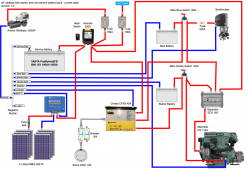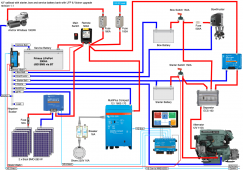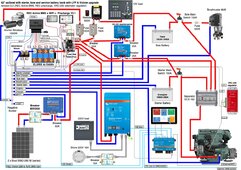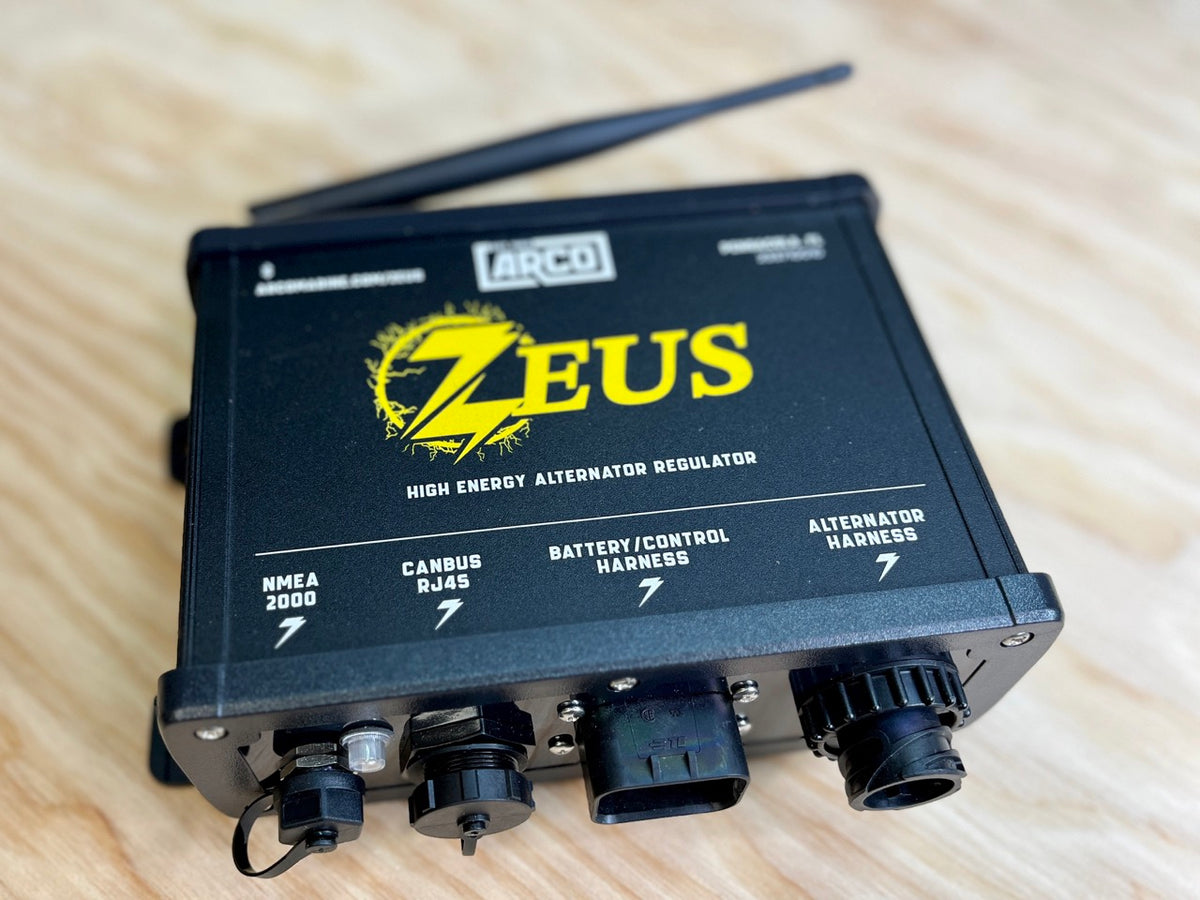Lure
New Member
- Joined
- Mar 12, 2022
- Messages
- 10
I have a 42" sailboat with 3 lead acid battery banks (starter, bow and house) + 560W solar system.
I mainly use the boat without 220V connection (max once a week), with limited engine use (0.5-1 hour / day). Solar currently provides enough charge for my daily use.
I currently have temporary 190Ah lead acid house battery (was put in when old pair of 2x 135Ah died) which I would like to upgrade to LFP.
At the same time, I would like to replace the old 220V charger (without LFP support) with a Victron MultiPlus Compact inverter/charger. I want like to keep as much as possible of the existing installation as it is quite good (oversized cables).
The current installation looks like this (drawing based on my observations/understanding):
- The starter battery is used only for the engine, the bow battery is used only for the bow thruster, and the house battery is used for the anchor windlass and all other loads.
- Current 220V 40A charger has 3 outputs and charges all three batteries.
- 115A "dumb" alternator is connected to all three batteries with 3-port charging separator.
- 100v/50a MPPT solar charge controller is connected only to house (service) battery.

I plan to upgrade the system with the following equipment:
- 200Ah marine grade LiFePo4 battery with built-in JBD BMS with BT control (with 5 year warranty, do not want to mess with own build)
- Victron MultiPlus Compact 12v/1600va/70a inverter/charger which will provide us 220V electricity up to 1300W everywhere (computers/gadgets, occasional hot water boiler 800W, vacuum 600W...)
- Victron Orion-Tr Smart 12/12-30a DC to DC charger for alternator to LFP charging
- Victron SmartShunt for SOC of house battery
- Victron Cerbo GX and GX Touch 50 for monitoring (local and remote)
This diagram is my current understanding of what the upgrade would look like with minimal wiring changes:

The old and new setups are missing only one thing: solar charging of the starter and the bow battery. The new setup with MultiPlus Compact also does not provide 220V charging as it only has one output (the old charger had 3 outputs). Most of the time, the starter and bow battery will be charged via the alternator (as the engine runs while they are in use), but that does not help when the boat in port or at anchor for several weeks.
I have read old threads with similar needs:

 diysolarforum.com
diysolarforum.com
The conclusion there is to put an additional DC-DC charger from the LFP house battery to the starter and bow battery. I think this might be a small 5-10A charger (AMP-L-START has been suggested) that provides more or less trickle charge.
However, my concern is that I would create charging loop (circuit): starter - alternator - DCDC - LFP - DCDC - starter.
Is this the right way to do it or should I do it differently?
Are there any other concerns with the above upgrade suggestion?
I mainly use the boat without 220V connection (max once a week), with limited engine use (0.5-1 hour / day). Solar currently provides enough charge for my daily use.
I currently have temporary 190Ah lead acid house battery (was put in when old pair of 2x 135Ah died) which I would like to upgrade to LFP.
At the same time, I would like to replace the old 220V charger (without LFP support) with a Victron MultiPlus Compact inverter/charger. I want like to keep as much as possible of the existing installation as it is quite good (oversized cables).
The current installation looks like this (drawing based on my observations/understanding):
- The starter battery is used only for the engine, the bow battery is used only for the bow thruster, and the house battery is used for the anchor windlass and all other loads.
- Current 220V 40A charger has 3 outputs and charges all three batteries.
- 115A "dumb" alternator is connected to all three batteries with 3-port charging separator.
- 100v/50a MPPT solar charge controller is connected only to house (service) battery.

I plan to upgrade the system with the following equipment:
- 200Ah marine grade LiFePo4 battery with built-in JBD BMS with BT control (with 5 year warranty, do not want to mess with own build)
- Victron MultiPlus Compact 12v/1600va/70a inverter/charger which will provide us 220V electricity up to 1300W everywhere (computers/gadgets, occasional hot water boiler 800W, vacuum 600W...)
- Victron Orion-Tr Smart 12/12-30a DC to DC charger for alternator to LFP charging
- Victron SmartShunt for SOC of house battery
- Victron Cerbo GX and GX Touch 50 for monitoring (local and remote)
This diagram is my current understanding of what the upgrade would look like with minimal wiring changes:

The old and new setups are missing only one thing: solar charging of the starter and the bow battery. The new setup with MultiPlus Compact also does not provide 220V charging as it only has one output (the old charger had 3 outputs). Most of the time, the starter and bow battery will be charged via the alternator (as the engine runs while they are in use), but that does not help when the boat in port or at anchor for several weeks.
I have read old threads with similar needs:

DC - DC Charger Placement in Sailboat LFP setup
I've spent many hours learning and scouring this great forum and the web, but still puzzling over best setup for my sailboat solar/LFP upgrade i'm planning early spring: Here's is a list of my planned equipment - all 12v: - Single diesel engine, 125A 'dumb' alternator - 1 110A AGM starter...
The conclusion there is to put an additional DC-DC charger from the LFP house battery to the starter and bow battery. I think this might be a small 5-10A charger (AMP-L-START has been suggested) that provides more or less trickle charge.
However, my concern is that I would create charging loop (circuit): starter - alternator - DCDC - LFP - DCDC - starter.
Is this the right way to do it or should I do it differently?
Are there any other concerns with the above upgrade suggestion?






